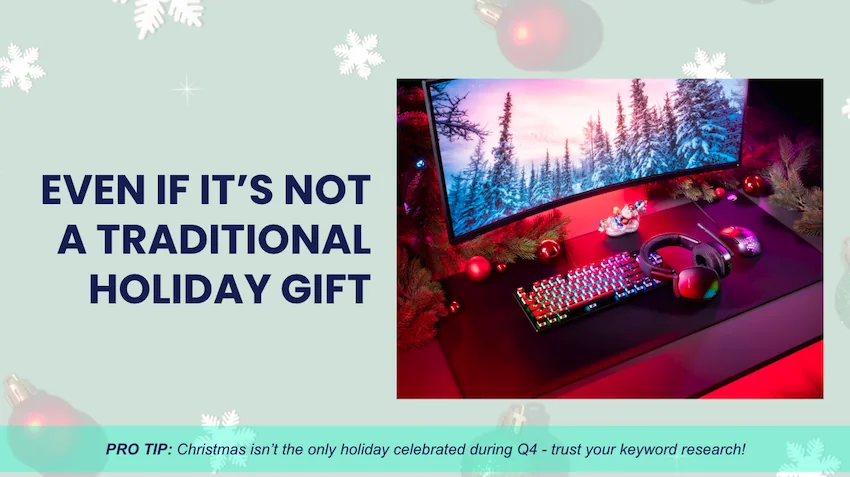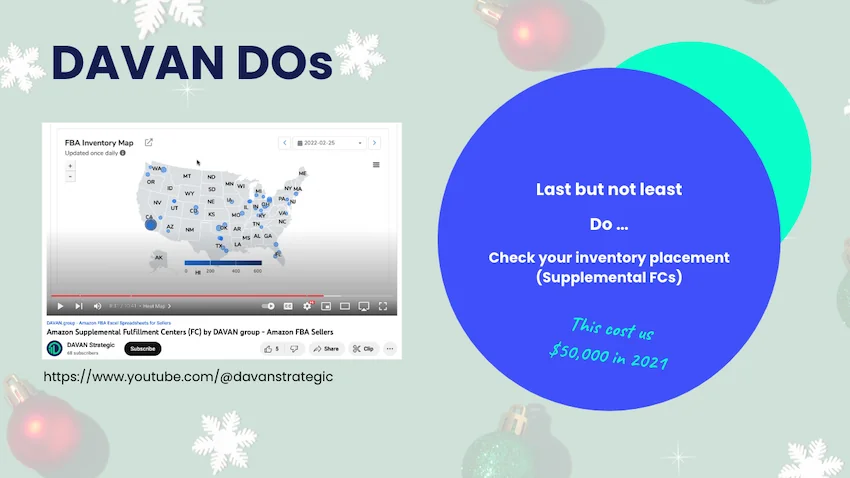In this webinar, Ryan Sherrard and David Lang of DAVAN share their biggest secrets for succeeding during Q4’s holiday season. Two seasoned eCommerce veterans, they have vast experience managing online stores during the Black Friday/Cyber Monday (BFCM) surge. Over the years, they learned hard lessons that new sellers can significantly benefit from, such as how to navigate Q4 sales strategies or how to ace inventory management. Here are some highlights from their discussion with 8fig’s Emma Borochoff and Katie Deter:
Ryan and David started the discussion with their recommendation on what to avoid and what to pursue as the Q4 holiday sales peak approaches. This includes how to prepare for holiday sales, increasing holiday sales conversion, and Q4 sales tips.
It is extremely important to find out which keywords performed best during last year’s Q4. This serves to get a better baseline of what keywords you should be looking out for this year. Also, keep an eye on what keywords are newly emerging. Amazon regularly tweaks its autocomplete suggestions, which has a big impact on keyword value. New keywords often emerge naturally as well.

Ryan and David strongly recommend researching keyword trends ahead of time. Search volume is crucial but relevancy matters a lot too. For example, Christmas gifts keywords will jump up in search volume but that doesn’t necessarily mean you should target them. Stay as relevant as possible with your keyword targets.
This period of increased demand is also a great time for cross-selling. The picture above features a series of Christmas products that are ideal for this. Featuring the same holiday theme, they fit well for cross-selling. Even if you don’t sell Christmas products, this is a great approach to have. When customer traffic reaches your page, make sure to showcase all your other products. Point shoppers toward your store’s page. You especially want to drive traffic here since there are no sponsored ads, only your products.
If you only have one hero product that ranked really well during Q4, use the traffic it generates to bring more customers to your page. Your other products will benefit from the additional visibility and any sales will count as organic, increasing their ranking as well.
Ryan and David recommend having inventory arrive by mid-November to be ready for Q4 sales. This means if you’re shipping from China it has to be sent well in advance. All your inventory should be dispersed across all your fulfillment centers at the very latest by December 1st.
You don’t want to forget to run deals on Black Friday and Cyber Monday, if only just to keep pace with your competitors, who will likely do so themselves. If you don’t, you risk slipping with your Amazon Best Seller Rank (BSR), which is relative to your niche, product category, and competitors.
This has to be done by setting a promotional price, which needs to be lower than in the last 30 days. When you reach 30 days before Black Friday, pricing should be at the forefront of your mind. Some sellers raise their prices slightly before this period and then run a discount for Black Friday, which simply returns it to the old price.

Christmasifying your listing doesn’t take a photographer or a studio, it can be as simple as taking the text in one of your images and making it green and red. It can be simple, as long as it tells customers who land on your page that this is something they could buy for Christmas. The above graphic of a gaming keyboard is a great example. The product itself isn’t a traditional Christmas gift, but it can feel more like it with the right presentation.
It is also important to remember that Christmas isn’t the only holiday celebrated during Q4. You should focus on product research, as there might be potential for adopting a Hanukkah theme, for example. It’s all about the search volume, use the tools at your disposal and trust the data. Ryan and David target whatever has the highest search volume. They follow an “80/20” rule, meaning that 80% of their effort goes into the 20% peak of the highest search volume.
Ryan and David are big fans of Helium 10 since they started out. This is because it offered very raw data 3-4 years ago. Users were able to export all of it in .CSV files. They love Excel and the ability to use their own data, so they stuck with Helium 10. In their view, most tools on the market are good, as long as you get used to them. If you trust and rely on their numbers, that’s all that matters.
Brand Analytics, which is part of Amazon Seller Central, is also very useful. It allows you to look into the keywords that people are searching for on Amazon, and how popular they are. Vendors also see search volumes and how well their products compare and convert. Seller Central has great tools for keyword research and deciding what to target with PPC (Pay Per Click advertising).

Amazon will sometimes decide that stores aren’t likely to sell all the inventory they shipped in and store it at a supplemental fulfillment center. Many sellers don’t know about this. It isn’t a general fulfillment center and will need to be shipped to one before goods can be sent to customers. This meant that Ryan and David’s shipping time rose to two weeks after their first batch of products ran out, which came as a surprise. It also lost them around $50,000.
They had decided to send a lot of inventory to Amazon in preparation for Q4. Sales ended up reaching 1 million within 30 days, an over tenfold increase compared to their average month. When their available units reached around 5,000 they noticed the delayed shipping time, to great confusion. Ryan and David had to go through loads of inventory reports and contact Seller Central before finding out what had happened.
If you notice or fear this might be happening to you, open a ticket early on. Explain your sales strategy, share your numbers, and ask Amazon to transfer your goods to a general fulfillment center early on.
The timing of when your inventory arrives is extremely important. You might be excited about Q4 and want to be ready early on. However, starting October 1, inventory fees nearly triple for most products on Amazon, rising even higher than that sometimes. Make sure that you don’t ship your inventory too early. It will sit in a warehouse, accumulate storage fees, and eat into your profits.
In general, Q4 is a bit of a misnomer, according to Ryan and David. It starts October 1, but eCommerce sellers mostly care about mid-November to mid-December. Sending inventory too late is also an issue. You want Amazon to receive your shipment in time to pass it on to their fulfillment center network. It will need time to spread out so that everyone across the country can access your products in time for the holiday season.
It is important not to push Christmas PPC too early in Q4. Ryan and David made this mistake themselves. They thought that consumers would already start thinking about Christmas in November. While that was correct, shopping momentum is still a few weeks off.
People were clicking on Ryan and David’s expensive campaigns targeting Christmas keywords, but they weren’t buying. November is still largely a window-shopping period. Some might think consumers are still adding to their carts to buy later. However, PPC has a limited attribution window, meaning you won’t see conversions outside of 7-14 days, depending on the campaign.
It is always good to focus on data. Test and stick with it. Aim for good conversion rates because low ones could hurt your organic ranking. The goal should always be to rank for the gifting keywords in your niche. Don’t just focus on Christmas gift keywords, get more specific. Most products can be turned into gifts if you target the right keywords.
While the holiday period is clearly the most lucrative time of the year, things don’t end there. Q1 comes right afterward and shouldn’t be disregarded. Many sellers get tunnel vision during Q4 only to make mistakes in planning for the following period. It is important to remember that the Chinese New Year happens during Q1 as well. Make sure to have your units shipped before then as the holiday slows things down significantly.